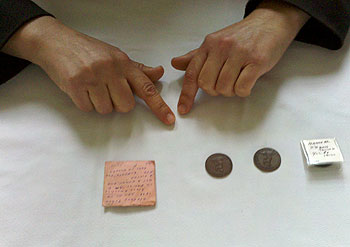I wasn’t sure what to take with me – the male and female anti-slavery tokens or the fragile Abraham Lincoln engraving. I knew some of the history of both, but I was curious to see if a “real” expert could offer more.
I was pondering them after seeing a notice in the local community newspaper about an upcoming presentation offering an insider’s view of the Antiques Roadshow followed by a panel that would provide some historical details about your artifacts. I had been to a similar event a couple years ago where an expert had appraised my original drawings by cartoonist Bo Brown.
This time, I wasn’t sure what to take – a dilemma we all share. We don’t want to waste our time or the expert’s time, or embarrass ourselves with items of little financial but great sentimental value. Sessions like these are a great way to learn more about your artifacts or family heirlooms, and in some instanes, get a ballpark appraisal.

So, I took the anti-slavery tokens I had bought at auction in August. There were three of them: two with a kneeling slave woman and one with a kneeling slave man. Both were based on an image created in 1787 by English potter Josiah Wedgwood as an abolitionist tool. The original was a male, one knee on the ground, the other upright, with his chained hands folded toward heaven. “Am I Not A Man And A Brother” was embossed around the edge of the coin.
In this country, abolitionist men and women were also fighting for that cause, and picked up both the Wedgwood symbol and a corresponding female image whose origin is unclear.
At the session sponsored by the Germantown Historical Society (GHS) in Philadelphia, four experts sat at a table as 25 of us waited in lines to have our items examined. They were there to give us some history about our items, not necessarily to put a value on them. The panel consisted of a generalist (who said she knew a little about a lot of things), and experts in ceramics, historical prints and utilitarian items (he had a display of vintage bottles that he had dug up).
The longest line was for historical prints, and the expert was Antiques Roadshow appraiser Don Cresswell, a 12-year veteran of the program who was the speaker that day. I stood in line to see the generalist Kristen Froehlich, director of the collection at the Philadelphia History Museum.

Froehlich was fascinated with the tokens, and said she had not seen one before. She told me some history about them, mentioning Wedgwood and another name I did not recognize. She said she believed that they were used to raise money in the abolitionist movement. She was right on the mark, because that was some of the same information I had found in my Googling.
She was so intrigued by the tokens that she said she’d do more research. And she did. She sent me a link to the Colonial Williamsburg Foundation site, which noted that Wedgwood had made stoneware cameos and given them away to abolitionists. The symbol was first adopted by the Society for the Abolition of the Slave Trade in England. It was used not only on coins in England and here but also household items, including samplers and sugar bowls – photos of which are on the site.
The female symbol – “Am I Not A Woman And A Sister” – was one that white female abolitionist groups apparently took to heart at a time when women had very little standing. Froehlich mentioned an 1838 anti-slavery convention in Philadelphia, the same year embossed on the back of my female token.
Called the Anti-Slavery Convention of American Women, the group met for its second convention (the first was in New York) in Philadelphia amid an atmosphere of unbridled hostility. Handbills protesting the meeting had appeared even before the convention got started. On the first night of the convention, the 3,000 black and white women inside Pennsylvania Hall could hardly hear the speakers for the shouting mob, which was throwing rocks through windows from outside. The women were stoned and insulted when they later went out. The next day, the mob burned down the building, built by abolitionists and dedicated only four days earlier.


Karen Froehlich, of the Philadelphia History Museum, talks about the history of my anti-slavery tokens.At the GHS session, I was so hyped from talking to Froehlich that I drove home to get my Lincoln engraving. I got into the Cresswell line behind two other people, waited and finally showed him the print. He dated it to the 1860s, and noted that it had been backed with wood. I had picked up other antique prints at auction with wood backs, so I assume that was common.
I was interested in whether it was worth conserving. It would cost about $350 to clean it up, he said, but there was nothing that could be done about a dark line across the center. And that’s about what it was worth. In its current condition, he said, it was not worth much.
He was right, and I knew that when I bought the print at auction for less than $100, but I got it for its historical value – at least, that’s what I told myself. I’ll keep it covered and won’t bother to preserve it for now. I think I can find at auction something of much better value at a price far less than $350.
